Wrap your hands around these warm, soft, pliable Gluten Free Pita Bread filled with salad, falafels, or gyros.
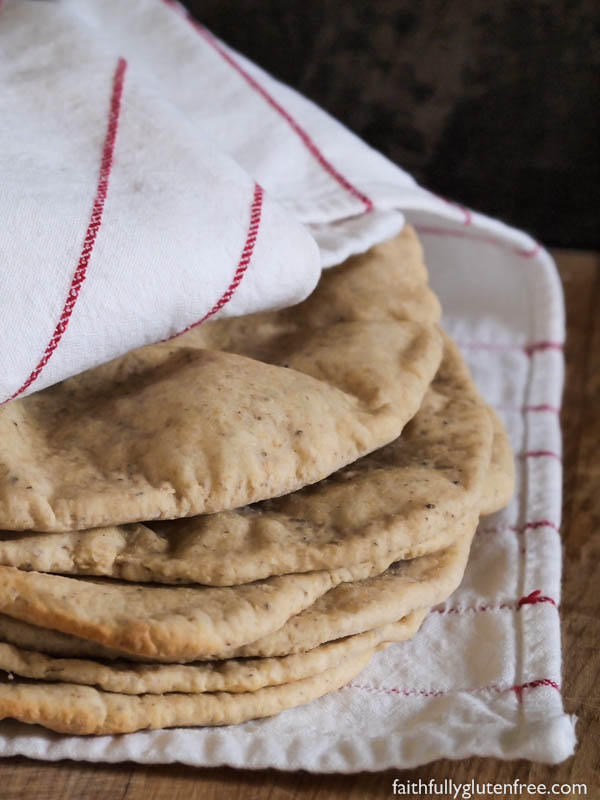
I am very excited to share with you that from now until September, I will be a brand ambassador for Avena Foods. What is Avena Foods, you might be wondering? If you’re in Canada, you may recognize the name on their packaging – Only Oats.
Located in the heart of the prairies, Saskatchewan, Avena Foods is a major producer of wheat-free oats and oat products. Whether you’re looking to add steel cut, old fashioned rolled, or quick cook oats to your gluten free diet, they have it all. In addition to their line of oats, they also have a line of ready-to-bake mixes like pancake mix, oatmeal cookie mix, cinnamon spice muffin mix, and decadent chocolate muffins (who are we kidding – those are cupcakes).
This recipe was developed as part of my partnership with Avena Foods.
When I was newly diagnosed with celiac disease 6 years ago, I was saddened to learn that regular, commercially produced oats were off the list. Even though oats themselves do not contain gluten, through the growing and manufacturing process, the oats were contaminated with gluten.
A few months into my gluten-free life, while browsing the internet, I learned of Only Oats. At the time, gluten free products were not as readily available as they are now, you couldn’t just go to store and pick up a package of gluten-free oats. They were having a sale – free shipping on orders over $50 – and I quickly placed an order. Being able to add oats back into my diet was a huge blessing. After all, oatmeal chocolate chip cookies just aren’t the same without them!
There’s no need for you to order oats online anymore – purchasing Only Oats products has become as easy as going to your nearest health food store or Bulk Barn. Looking to save some money? Here’s a tip – Bulk Barn often has a coupon for $3 off a $10 purchase. Even if you don’t feel safe buying their bulk flours, you can purchase the pre-packaged Only Oats products there, and save some money while doing it!
Can I eat oats if I have celiac disease?
If you are diagnosed with celiac disease, can you eat oats? According to the Canadian Celiac Association, Yes! However, there is a small fraction of those that have been diagnosed with celiac disease that can not tolerate even pure oats. If you haven’t tried eating gluten free oats after going on a gluten free diet, introducing them to your diet gradually may be a better fit than cooking yourself a bit pot of oatmeal.
In the US, the Food and Drug Administration allows oats can be certified as “gluten free”. In Canada, however, the Canadian Food Inspection Agency does not currently define pure oats as being gluten free. That being said, Avena Foods oat products are tested using the R5-ELISA test, and the oats test at under 5 ppm (which is considered undetectable and safe for those with celiac disease).
Benefits of adding oats to your diet.
Adding oats to your diet can be very beneficial. Oats have been proven to:
- lower bad cholesterol
- lower the risk of heart disease
- help regulate your blood sugar
- keep you regular
- be a great source of iron and plant protein
See for yourself how oat flour compares to other gluten free flours.

Not to mention, oat flour also helps improve the flavour, texture, and moisture of gluten free baked goods. That’s one of the reasons I decided to use it to make gluten free pita bread. I hadn’t had pita bread since going gluten free. Even with all the new products that I’ve seen come into the stores, I haven’t even seen a gluten free pita.
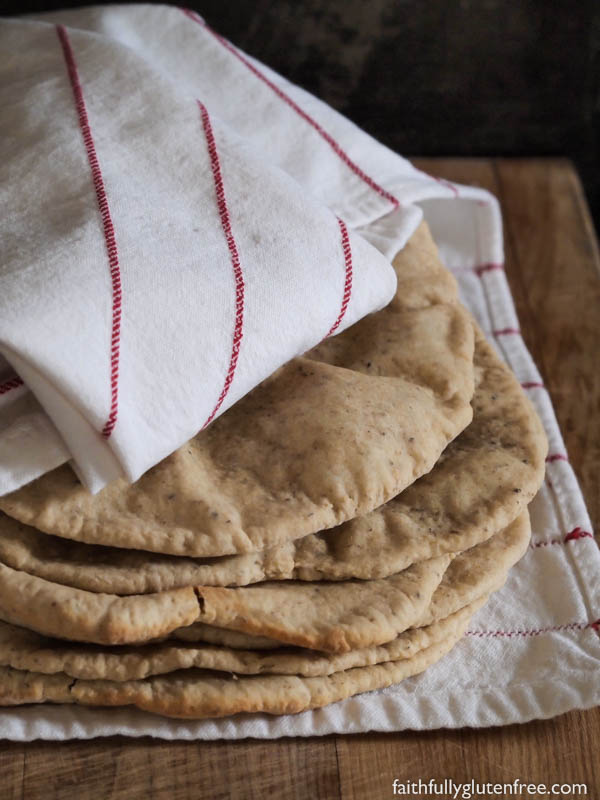
This pita bread is soft, pliable, and perfect to wrap around a salad, falafel, or gyro. The pita puffs up beautifully when baking too, giving you a full pocket that you can fill, but I did find the pocket walls to be a bit thin, sometimes resulting in a torn pocket.
Like all home-baked goods, these are best served fresh and warm. You can reheat them by wrapping them in a damp paper towel before microwaving it for a few seconds.
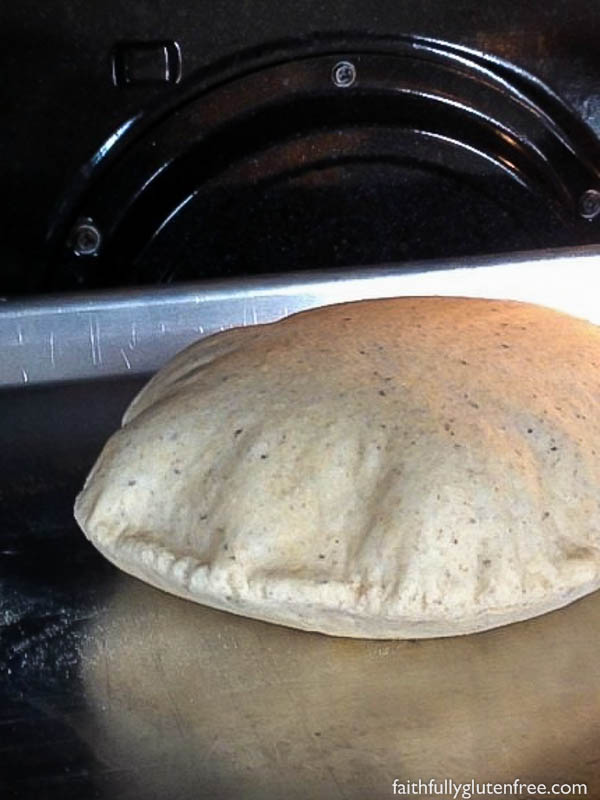
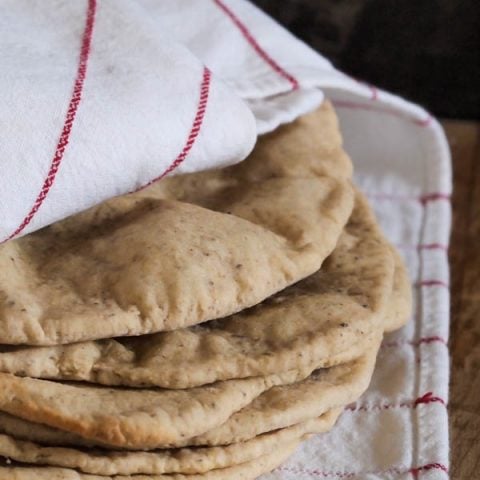
Gluten Free Pita Bread
The secret to getting the pita to puff is having a very hot oven, with a preheated baking surface. Wrap the baked pitas in a clean towel to keep them soft.
Ingredients
- 1 1/4 cup Only Oats pure whole grain oat flour
- 1/2 cup potato starch
- 1/3 cup cornstarch
- 1/3 cup tapioca starch
- 2 tablespoons psyllium husk powder
- 1 tablespoon ground chia seed
- 1 tablespoon rapid rise yeast
- 1 teaspoon granulated sugar
- 1 teaspoon salt
- 1 cup warm milk
- 1 large egg, room temperature
- 1/4 cup oil
- 1 teaspoon apple cider vinegar
- rice flour, for rolling
Instructions
- Measure the oat flour, potato starch, cornstarch, tapioca starch, psyllium husk powder, ground chia seed, yeast, sugar, and salt into the bowl of a stand mixer. Whisk to combine.
- Whisk together the milk, egg, oil, and vinegar.
- Add the wet ingredients to the dry ingredients, and mix on medium/low speed for 5 minutes. This allows the psyllium husk powder and chia seed to absorb the liquid, and the dough to thicken.
- Line 3 baking sheets with parchment paper.
- Divide the dough into 6 pieces, each being just bigger than a golf ball. Lightly flour the counter with rice flour, and sprinkle a little flour on top of the dough. Roll the dough into a 6-inch circle, turning frequently so that it doesn’t stick to the counter. Place rolled out dough on the prepared baking sheet. Repeat until you have 6 pitas (2 pitas per sheet).
- Lightly cover the pitas with plastic wrap and let sit on the counter for 1 to 1 1/2 hours.
- Place a heavy baking sheet or a pizza stone in the oven and preheat the oven to 450 degrees F. Having a very hot oven is very important, it is what will make the pitas puff up while baking.
- Spray two pitas with water, slide out the oven rack, and carefully place them on the hot baking sheet/stone. Close the door and let the pitas bake for 5-7 minutes, or until they are puffed up and lightly browned.
- Carefully remove the pitas from the oven and place them in a clean, dry tea towel, covering them. This will help the pita bread to stay soft.
- Repeat with the remaining 4 pitas, letting the oven heat up a few minutes between batches.
- Best served fresh and warm.
Psyllium Husk Powder and Ground Chia Seeds can both be purchased at health food stores or on Amazon. If you are only able to find psyllium husk, you can grind it finer using a coffee grinder.
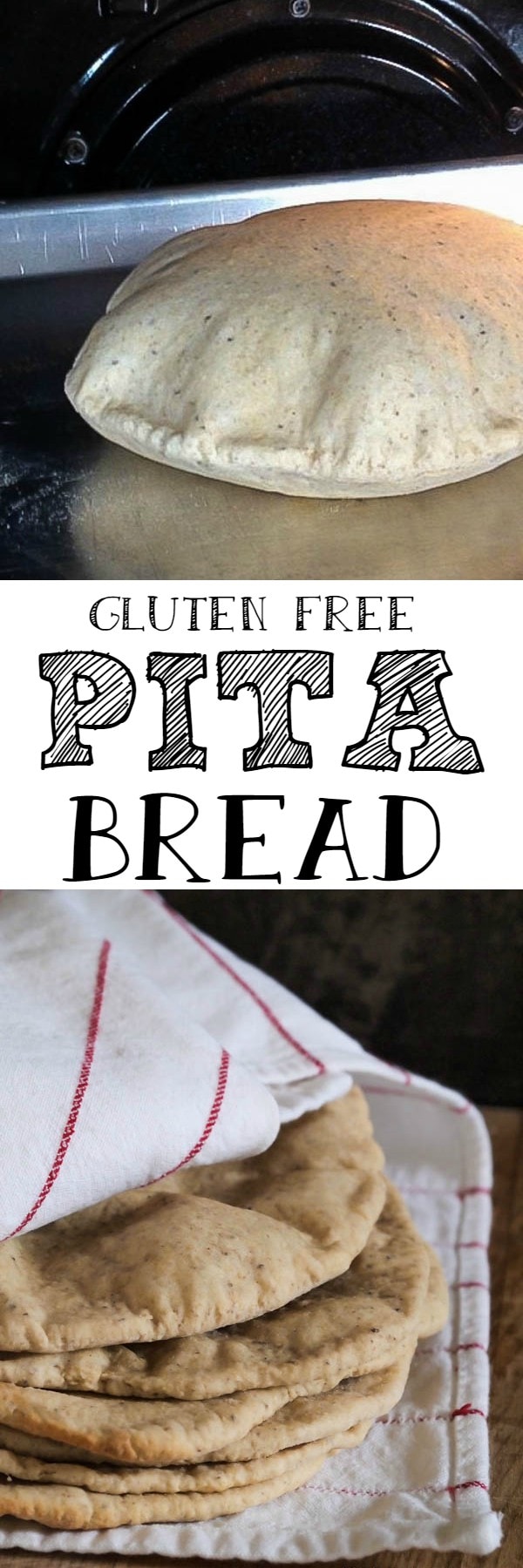
Disclosure: I received compensation in exchange for my participation in this campaign. The opinions on this blog are my own. We are a participant in the Amazon Services LLC Associates Program, an affiliate advertising program designed to provide a means for us to earn fees by linking to Amazon.com and affiliated sites.

Alma says
I assume the yeast goes in with the dry ingredients, ( step 1 )?
Thanks
Jeanine Friesen says
Thanks for catching that, Alma! Yes, you’re right, I fixed it now.
Sher says
Will the recipe work without the yeast?
Thank you for your time and talent!
Jeanine says
I don’t think it would Sher, I’ve never tried though.
Wendy says
Will flax work as well as the chia?
Jeanine Friesen says
I haven’t tried it with the ground flax, Wendy. The chia seeds really gel up a lot, even compared to flax, so I’m not sure if it would work the same way or not. If you decide to experiment with it though, please let me know!
MsGF says
I went to print the recipe but the print icon in the recipe square is only bringing up a blank page. Never had that happen before. I cut and past it into word to print it.
Can’t wait to try it.
Jeanine Friesen says
Sorry about that – I was notified this morning that there is a hiccup printing the last 2 recipes. I have no idea why, but am looking into it! Smart move on copy & pasting into Word. Thanks for sharing!
Cassidy @ Cassidy's Craveable Creations says
These look A-mazing!!!! I haven’t had any pita bread since going gluten free!
Jeanine Friesen says
Thank you, Cassidy!
Barbara R. Briody says
Do these have to be rolled, or could they be pressed? I live in south Texas, where a tortilla press is a great way to “squish” a ball of dough into a circle [and one resides in my cupboard].
‘Nother question: I live alone, so half a dozen pitas would last me a week or more; would you suggest baking the entire batch in one session [most energy efficient, presumably] and then storing (freezing?) for later reheating and use?
These look like they could be used in place of the traditional flour tortilla for use with eggs, sausage & cheese for breakfast, or with diced grilled meat & veggies for another meal.
Really like to see what you come up with every time my e-mail reports a new post – thanks for helping us gluten-intolerant folks have the equivalent of a “normal” diet.
Jeanine Friesen says
Hmm.. those are some good questions, Barbara! I think I’d opt to roll instead of press. You don’t want these to be as thin as a tortilla once they are rolled out, plus, how often can you actually use a rolling pin with gluten-free dough?? 🙂
I haven’t tried it myself, but here’s what I’d do if I only wanted to make a few at a time…
I would roll out all 6 of them, then I would flash freeze them right away on parchment paper (single layer), and then wrap them and store them in a ziplock bag. When I wanted fresh pitas, I would remove them from the freezer, let them sit on a baking sheet for the same amount of time (1 to 1 1/2 hrs) in a warm, draft free place, and then bake as normal. I ‘think’ it should work… and that would give you 1 or two fresh pitas each time. I don’t think the bread itself would freeze well.
Barbara R. Briody says
You may want to edit your reptly – they’d need to be removed from the Freezer to warm up before being put into the Oven.
Thanks.
Jeanine Friesen says
Ha, YES! Remove from the FREEZER. Sorry – fixed it now. 🙂
T says
I’ve made and frozen these, and then heated in toaster oven (on pan with piece of foil loosely covering)…they were just like fresh baked!
Jeanine Friesen says
Wonderful! Thanks for the comment, I appreciate it!
Cindy @ Hun... What's for Dinner? says
This pita bread looks fantastic Jeanine!!
Jeanine Friesen says
Thanks, Cindy!
Syndisue says
do you think a non dairy milk would work in this recipe?
becca says
I made it with soy milk and it worked fine. 🙂
Kathy says
Wow these look amazing! Looking forward to making them!
Just a tip about the psyllium husks- I have switched over to using psyllium instead of xantham gum and have never had a problem using the husks rather than powder. I just add the psyllium husks to whatever liquid the recipe calls for and let it sit for about 5 minutes so that it can re-hydrate and gel. Very simple!
If using as a subsitute for xantham gum just use the same amount of psyllium.
Katrina says
I was just going to ask what could be substituted for psyllium, so xantham? But not 2 tablespoons, right? I’ve been meaning to get some psyllium powder anyway.
Jan says
These do look delicious, but I can’t use eggs, do you think egg replacer powder made up to 1 or 2 egg size would work since the recipe already has some chia & psyllium which is what I use quite often to replace an egg or two?
Michelle says
I just made this recipe with 1 TBS ground flax mixed with 1/4 cup warm water instead of egg. They are delicious. The texture is different but they are delicious. I forgot one in the oven so it probably got 10 minutes in the oven. I love it. It reminds of the crust on fresh baked whole wheat bread. I haven’t had anything comparable in 25 years. Thank-you, Janine.
Crystal says
So excited! I was lamenting not having pita with my falafel a last night. Cannot wait to try this recipe.
Robyn says
Can’t wait to try these! And to picking up some Only Oats.
Lissa says
Hi Jeanine,
I made this tonight and it was light and soft and tasted delishious! It did not puff up properly though. There were a few small puffs but not the whole thing like you picture. I used a heavy baking sheet…do you think the problem might be not using a pizza stone? I also measured after trying to figure out where i went wrong and mine were 7 inches, instead of 6 inches, could that be it? I did love working with this dough! Keep up the great work!!!
Jeanine Friesen says
Hi Lissa, It could be that they were just a little too thin. I’ve made them on a heavy baking sheet too, just be sure that it is HOT! Have the pan in the oven while it’s preheating, and then let it continue heating 10 minutes before baking anything. I also give it a few minutes to warm up between batches, since I had the oven door open. Do you use an oven thermometer? Heat really is the key to getting them to puff nicely.
Susi says
These look great. I bake for my gluten free customers at our local farmers market, and these look like a great add to my menu. Can you use something other than pysllium in the recipe, maybe ground flax seed? I haven’t used psyllium yet in my baking.
Jeanine says
Hi Susi, unfortunately, the psyllium husk and chia seed combo is what makes this recipe work. I don’t think anything else would work.
Jacquie says
Is there any alternative to the ground chia seeds that I could use?
Jeanine says
Hi Jacquie, I don’t think you could replace it – nothing else works quite like it. the ground chia seed and psyllium husk combination is really what makes this recipe work.
Judee@ Gluten Free A-Z Blog says
I have to admit that I seldom bake, but I am pinning your recipe in case I ever do . I can see you are a master. Can’t believe you can make gluten free pita look so amazing.
Jeanine says
Haha, thanks Judee! Hope you get to baking sometime – these pitas are great with falafels or gyros!
Dick L. says
Made this recipe this afternoon, and it turned out well. I’m nibbling on a chunk of one now and it comes pretty close to a wheat pita, although not quite as chewy as a good one. But it’s far better than the pita that comes with the gyros at the local gyros place. (I only got diagnosed with celiac Sept 2013, so I can still remember what that was like.) I’ve been using psyllium husk powder for a while, but this is the first time I’ve used chia seeds. I ground the chia seeds in a spice grinder along with the sugar (to keep from getting an oily mess); that worked well. I found the dough quite easy to work with, with a texture closer to wheat bread than most GF breads. It rose nicely within the time specified in the recipe. I’m planning to try it as pizza crust sometime.
I live near Chicago and am able to get MyBread flatbread (mybreadbakery(dot)com), which is also very good, but rather expensive. Homemade is certainly less costly, and fun, too, when the results are so good. The MyBread ingredients include rice flour and tapioca starch, with xanthan gum, egg and egg replacer (which contains potato starch, cellulose gum and modified cellulose among other things), so the flavor, texture and appearance are different. It has a more bland flavor, as one might expect.
Thank you for your effort in developing and posting the recipe. It’s certainly a keeper.
Sonia says
Is it possible to buy you gluten fre pita bread online?
Jeanine says
Sorry Sonia – just the recipe (but it’s free!) 😉
Kathleen Ruelling says
I can’t wait to try this recipe! As the mom of a child with celiac disease, I’m often frustrated by the bread products (so is my daughter). These look perfect, and will be great stuffed with all kinds of yummy fillings.
Thanks!
Kathleen Ruelling
Edmonton, AB
Lilu says
Hi Kathleen
I understand your frustration in regards to bread, my daughter was diagnosed almost a year ago and the bread was a terrible thing for her. We found Larry from Montanas Gifts of Nature and started making an oat bread that they sell and is so good, it’s the only bread she likes.
you should give it a try.
Yisak says
Thank you for sharing Jeanine, this is really helpful. The pitas on the picture look amazing.
My question is will the recipe work with teff flour which is another gluten free grain.
Thanks,
Yisak
Jeanine says
Hi Yisak! I haven’t tried it with teff flour, sorry! If you do, please let me know how it worked for you!
Katelin says
First of all, let me say that this recipe is good. The formula for the dough is excellent. It’s pliable and holds together strongly, even with the substitution of flax seed meal for the chia seed. The puffing is the problem. However, it can work – but not with the instructions provided.
If you’re having trouble getting your pita to puff, like I did, try this: instead of dividing the dough when it’s finished mixing, let it rise in a lightly greased bowl (bulk fermentation). See, the yeast will not have an opportunity to digest all of the sugary fuel when bulk fermented, as it does if the dough gets divided after mixing. So divide after the 1-1.5 hour rise at room temp, or when the dough is roughly doubled in size.
This is part one of the no puff dilemma, easily solved.
Part two is the thickness of the pita themselves. When making flatbread, one is generally directed to roll the dough out as thin as possible – this, combined with high heat, is what makes a pita puff. This applies to both gluten and non-gluten puffed flatbreads. I found that dividing the pita into 6 equal portions got me a very thick pita, which is near to impossible to puff, no matter how hot the oven. Dividing the dough into 10 equal parts will get you thin, 6-inch diameter pitas, and they will puff!
Serena says
Would arrowroot starch likely work as a sub for the corn starch? (Corn allergy)
Jeanine says
I haven’t tried it, Serena, but I think it should work without a problem.
Mandy D says
I tried it last night with arrowroot powder instead of corn startch and it turned out great!!
Daphne says
Thanks so much for the recipe.
I wanted to let you know that I made the dough for donairs yesterday, but was pressed for time. So instead of baking them, I skipped the rising time and rolled the balls out quite thin, frying them in a dry pan for two minutes a side. They made quite a decent substitute for flour tortillas. I love that the dough is soft but stiff and quite easy to handle.
Dick L. says
Last week I made another batch of the pitas, which I really like. I misread the recipe and used only half the oil called for, but it didn’t cause any problems. I used Bob’s Red Mill GF Oat Flour in them, and I have the feeling that it is a little too coarse, but that could just be a matter of taste. I found that after mixing the ingredients thoroughly (by hand– no stand mixer), the texture of the dough really improved by five or ten minutes standing before forming the pitas.
Finally a couple of nights ago I got around to trying this as pizza crust, and it worked fine. My flour this time was Montana Gluten Free Raw Oat Flour, (they also sell a toasted version). I think this flour is a little finer than the BRM version, and the dough seemed to be smoother. Again, used a half portion (2 Tbsp) of oil. This time I let the dough rise until roughly doubled (about an hour) in the pan. Took 1/6 of it to be baked as a pita round, formed and rolled rest into a 13.5 inch round. Par-baked for 6 minutes on parchment on stone. Topped and removed parchment, baked directly on stone. Pizza was very good, with a crisp crust on the bottom and a nice bready, non-doughy, non-soggy interior. Pieces were not floppy, could eat out of hand. Tender edges with crisp crust, not very hard like some flour mixes produce.
So thanks again for the formula– it really works. (And BTW, thanks for the weight in grams for the dry ingredients– that makes mixing quite a bit easier, and saved me the trouble of converting the volume measurements.)
lily says
hi i live in new york and have not tried this recipe yet but it looks amazing! Does anyone know where i could find the only oats flour?
Dick L. says
The Avena/Only Oats website has information about where to buy it. For Canadian customers they have a store locator. They list two websites, one for Canada and one for the rest of the world, where you can order their products. The Montana Gluten Free flour that I mentioned can be ordered from their website or from Amazon.
cindy says
I made my own oat flour by grounding organic oats in my coffee grinder. Worked perfectly. Also I put some rounds in the freezer and took them out and directly placed them in a hot oven frozen because I didnt have time to let them rise. They were still delicious, not as puffy but soft and chewy for dipping in balsamic and garlic oil.
Tessa@tessadomesticdiva says
I had fun with this recipe Jeanine! I had no luck with the puffing so chose to cook them in my cast iron skillet with a touch of oil. the result was an excellent perfectly pliable tortilla! The one S I tried to bake turned out much drier.
I subbed the corn starch with more tapioca too. Thanks!
Pam Solomon says
Hi Jeanine, I made this pita recipe last night and was thrilled with the results!! I have tried several other recipes and this was the only one that actually puffed up like beautiful bread pillows.
Thank you for this recipe,
Pam
Jeanine says
Thank you, Pam! So glad to hear that! It’s all about the heat – HIGH heat.
dee says
Hi Jeanine – this is a great recipe.. Is it possible to replace the potato starch with more corn or tapioca starch? thx
Jeanine says
I haven’t tried it, dee, but you’re welcome to. I think it would work alright.
Kimberly Azelton says
I’m new to cooking GF and am used to raising the wheat pita dough before baking. I didn’t see that in this recipe. Is that correct?
-thanks
Jeanine says
Hi Kimberly. They rise after forming (Step #6), but not before, you’re correct.
Shona Douglas says
Hi Jeanine,what would I suvbstitute for the oats as I don’t eat them?Also Do you have a recipe for Gf wraps?
Jeanine says
Hi Shona, sorry, I have no suggestions for the oat flour. This recipe was developed around using oat flour, so I haven’t tried substituting anything else. Sorghum may work, but I haven’t tried. I don’t have a GREAT gluten-free wrap, but my friend Megan does, you can find her recipe here: http://www.allergyfreealaska.com/2014/04/09/grain-free-vegan-tortillas/
Louise wolsey says
Hi do you sell ready made pitta breads
Jeanine says
No, Louise, sorry, I don’t.
Bridy says
Unfortunitly I ended up with flat bread instead of Pita bread. I am not sure what went wrong. The dough was amazing to work with though.
I had a couple Pitas that got bubbles on half and a few that had no bubbles at all.
Tilly says
I used the pita bread recipe for a pizza crust this weekend. It was excellent! I mixed the dough in my bread machine and then divided it into 3 portions and rolled to flatten. I let them rise slightly and par baked them before adding the toppings. The dough was amazing and so easy to handle.
Jeanine says
That psyllium husk really is amazing in gluten-free baking, I definitely need to play with it more. I can imagine that this would make great pizza crust though. Thanks for sharing, Tilly!
Lyn says
Hi thank you for the recipe it looks delicious. I am both Celiac and nightshade free therefore am unable to use potato starch,. Can the potato starch be substituted with another starch and if so which one would you recommend. I know each one works slightly different.
Thank you
Jeanine says
Thanks, Lyn! I’d give arrowroot a try. I don’t use it, but it can be substituted for potato starch.
Megan says
I finally made this recipe…I only had it printed off for a year…I am so mad at myself for not making it sooner. These pitas were AMAZING!! And the dough was so easy to manage. Thank you thank you thank you!!!
Kirsty says
I made this last weekend for a gluten intolerant guest, I could not find psyllium husk, but instead used only chia seeds to make up for psyllium. The dough was quite sticky and soft, but it could be the omission of psyllium or the weather here in Asia. Pressing it out between parchment paper sheets and lots of Teflon flour to stop it sticking worked and they were delicious. I’m thinking next time to reduce the oil as someone else mentioned, or reduce some of the milk. They did not puff up, but for the use I intended, it was not necessary. I don’t have a pizza stone and I just put the baking paper directly to the wire rack, very tasty, I will try a again as I have all of the ingredients. Thanks
Kirsty says
I made this last weekend for a gluten intolerant guest, I could not find psyllium husk, but instead used only chia seeds to make up for psyllium. The dough was quite sticky and soft, but it could be the omission of psyllium or the weather here in Asia. Pressing it out between parchment paper sheets and lots of Teff flour to stop it sticking worked and they were delicious. I’m thinking next time to reduce the oil as someone else mentioned, or reduce some of the milk. They did not puff up, but for the use I intended, it was not necessary. I don’t have a pizza stone and I just put the baking paper directly to the wire rack, very tasty, I will try a again as I have all of the ingredients. Thanks
Lisa says
I am allergic to psyllium. Is there a substitute I may use to get the same result?
Thank you.
Jeanine Friesen says
Hmm… I’m not sure, sorry. This one uses psyllium in place of xanthan gum, but I haven’t tried making them with xanthan gum.
Sandra says
Thank you for this recipe!! I have yet to try it but I thought to ask you if you can do a video for this pita recipe? I’m not much of a bread maker and being able to watch someone make this will help a lot!! Thank you!!
Mary says
Hi there,
I made the GF pita recipe yesterday. I noticed that the dough was more like a batter and I couldn’t roll it as it was literally like cake batter. I tried adding more oat flour and it seemed to help. The pitas are flavourful for sure. The texture seemed good.
It would really help to have a demonstration video or pictures at each stage of the recipe to show what the product should look like. As well, sometimes having the exact weights of each of the flours is helpful. I have a scale and I weigh all my ingredients when I’m baking any GF cakes/breads.
Thank you for sharing it and it does taste great.